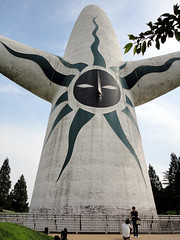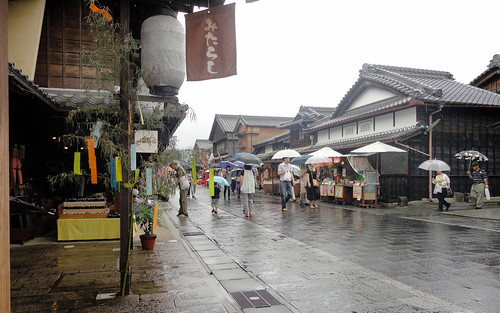I had a vague idea to visit the sight of the 1970 Osaka World Expo while I was in Japan last month, but not much of plan before I went. On the express train it's almost a 2 hour journey from the in-laws place, so I took with me one of my favorite manga, 20th Century Boys by Naoki Urasawa. One the advantages of a month of holidays is the time to read and wander aimlessly. I was almost to the end of the series, so it was a good opportunity to finish the last two volumes.
There were posters advertising 40th Anniversary of the 1970 Osaka World Expo at the station when I arrived at Namba. After a quick bento I studied the station map and jumped on the subway to the North of the city and the monorail which connects Senri Chuo station with Expo Commemoration Park.
In Japanese Expo '70 is known as Ōsaka Banpaku (大阪万博). The theme was "Progress and Harmony for Mankind." This was the first World's Fair held in Japan and one of the most well attended world fairs in history with almost a third of Japan's population visiting it over a 6 month period.
There are only a few remants of the expo remaining, including Tarō Okamoto's remarkable Tower of The Sun, which dominates Senri hill. As you approach from the west the tower is visible from a great distance. Okamoto was member of the Paris avant garde in the 1930's and had a deep fascination with the occult. Perhaps you can see this in the totemic style of the three external faces of the tower.

 On the front you see the present flanked by red thunder. The golden disk at the top represents the future. On the back is the black sun of the past. The interior was once open to the public, who could rise to the full heigh of 70 metres on an elevator and moving staircases. In the centre of the tower was another artwork callled the tree of life, and in the basement another face, the sun of the underworld.
On the front you see the present flanked by red thunder. The golden disk at the top represents the future. On the back is the black sun of the past. The interior was once open to the public, who could rise to the full heigh of 70 metres on an elevator and moving staircases. In the centre of the tower was another artwork callled the tree of life, and in the basement another face, the sun of the underworld.The park was planned by the Japanese architect Kenzo Tange, and the structures contained within represented the peak of human engineering acheivement at the time. Highlights included early mobile phone prototypes, local area networking and maglev train technology.
Take for example the United States pavilion - extraordinary for not only the technical and architecural innovation it embodied, but for the low cost of construction - made from only four materials for less than half a million dollars. The long span cable stiffened pneumatic dome, the first of it's kind, became the model for the majority of sports domes in existence today. All that is left of the United States' pavilion is a plaque commemorating the place where it stood and the hugely popular moon rook that it housed.
The expo is situated in time between the uncertain post war years and boom years of the later part of the century. Embued with an optimism for the future, Expo '70 undoubtably had a lot to do with inspiring Japan to become the advanced technological nation it is today.
A brisk walk around the park takes two hours and is well worth it, with a wide variety of gardens and sculptures along the way. In July it was 32 degrees celcius in the shade, so not too many people were around. Though I probably wasn't allowed, I took the opportunity to cool off in a stream in the middle of a secluded forest.
Through the forest runs an elevated observation pathway, which at it's furthest end stands a massive observation tower. The tower is onstructed entirely of wood and reminded me of the traditional architecture found within Japanese castles, only without an exterior facade.

AR大阪万博 by GORIMON, on Flickr
For many people I imagine a trip to the Expo '70 commemorative park is either to remember their first visit or some retro-futurism tourist jaunt. I wasn't there for an architectural tour or nature walk however, I was there to take a trip through the world imagined by Naoki Urasawa in his epic manga 20th Century Boys. It was a bit of of a manga geek trip, manga tabi if you will.
Expo 70 was a central to the story of 20th Century boys. First in 1970 as the ruse used by a young Fukube while he was writing the book of prophecy that would herald the bloody new years eve 2000 and he coming of a global government at the end of the world.
On that bloody new years eve, Kenji scaled the robot that was bringing death and destruction to Tokyo and came face to face with the tomodachi who stood on top of a gruesome replica of the Tower of The Sun.
The Tower of The Sun featured during the last stages as the place where the tomodachi plotted the assaination of the pope. The tomodachi then staged his own resurrection in front of the masses, becoming immortal in the process.
It was place that Kanna brought the people together for one final concert before the end of the world, and where Kenji roused the people of Tokyo to revolution.
Urawasa's epic work pulls together a whole host of post modern themes, bio-terrorism, mateship and betrayal, in a coming of age story that spans three generations. To wander around the park, which is dominated by the Tower of The Sun at the centre was to put myself in the picture. When you are culturally aware, the world seems an altogether different place.
Whatever your goals are for reaching fluency in Japanese, they must be accompanied by vision and imagination. You really need to be able to see yourself doing the the things you dream. And really, the book is much better than the movie.
You might also want to read other posts on this blog about manga:
- How reading manga can be good for your Japanese
- How to begin learning Japanese with manga
- How to put the fun back into Japanese now the JLPT is over
Thanks for reading, I mean that. You are what make this blog such fabulous place to learn about Japanese language and culture. Thank you for the support and the ongoing conversation on places like Facebook and Twitter.

